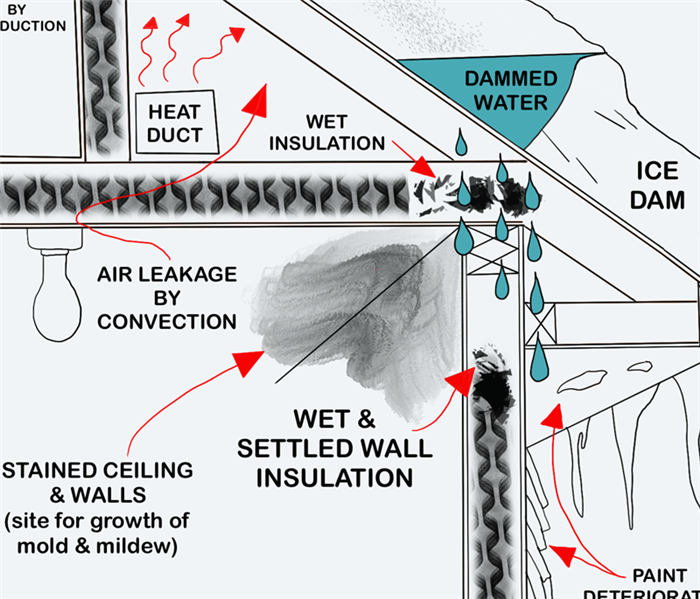Winter Storm Damage in the Eau Claire Area
1/2/2020 (Permalink)
Everything you need to know about ice dams
With temperatures teetering on the edge of freezing in the Eau Claire area, ice dams are in their prime to form. Eau Claire and Chippewa Falls saw about 8 inches of snow last week. That is plenty to form an insulating layer of snow, creating the perfect storm for an ice dam. SERVPRO of Eau Claire wants you to know what to look for before you get water damage or growth in your home.
So what is an ice dam?
An ice dam is a ridge of ice that forms at the edge of a roof that prevents melting snow (water) from draining off of the roof. The water that backs up behind the dam can leak into the building or home and cause damage to ceilings, walls, insulation, and other areas. Most of the time, it is not caught right away and where there's water that's been sitting, there is usually growth or the start of it. Don't worry! SERVPRO of Eau Claire is always here to help!
What causes ice dams?
The easy answer is nonuniform roof temperatures. Let's break that down a little bit further though. There are three things that all come into play for ice dams to form
- Heat loss from the building or home
- A layer of dry snow on the roof which creates good insulation
- Outside temperatures must be below freezing (32 degrees Fahrenheit)
If any of the above are absent, ice dams cannot form.
When building heat coming through the roofs surfaces melts the snow on the roof, this causes meltwater to flow down the roof until it reaches a place that is below freezing (eaves that don't get heat from the building). Once the meltwater reaches the frozen surface, it accumulates over time creating a barrier of ice that the meltwater gets caught behind.
How can you prevent ice dams?
- Know your snow load
Do you know how much weight your roof can hold? By removing the snow, it eliminates one of the ingredients necessary for an ice dam to form. You can use a push broom or a "roof rake" to remove the snow. In order for this to be effective ALL of the snow needs to be removed from the roof. If only part of the snow was removed from the roof, an ice dam will form where the snow was left.
*Please note that removing snow is only a temporary fix and can cause more damage to the roof. It's always a good idea to call in the professionals*
- Make the ceiling airtight so no warm, moist air can flow from the house to the attic space
Natural roof ventilation can help maintain uniform roof temperatures. If heat transfer has been reduced substantially, then snow will build up on the room and cover the ventilation systems, reducing attic ventilation. Natural attic ventilation systems are necessary to dry and remove heat build up from the attic.
Call us at 715-834-3572
SERVPRO of Eau Claire is available to help 24/7, 365 days a year. We've got a team of trained technicians that are ready, around the clock, for whatever happens.
Don't forget to check us out on Facebook @EauClaireSERVPRO





 24/7 Emergency Service
24/7 Emergency Service
